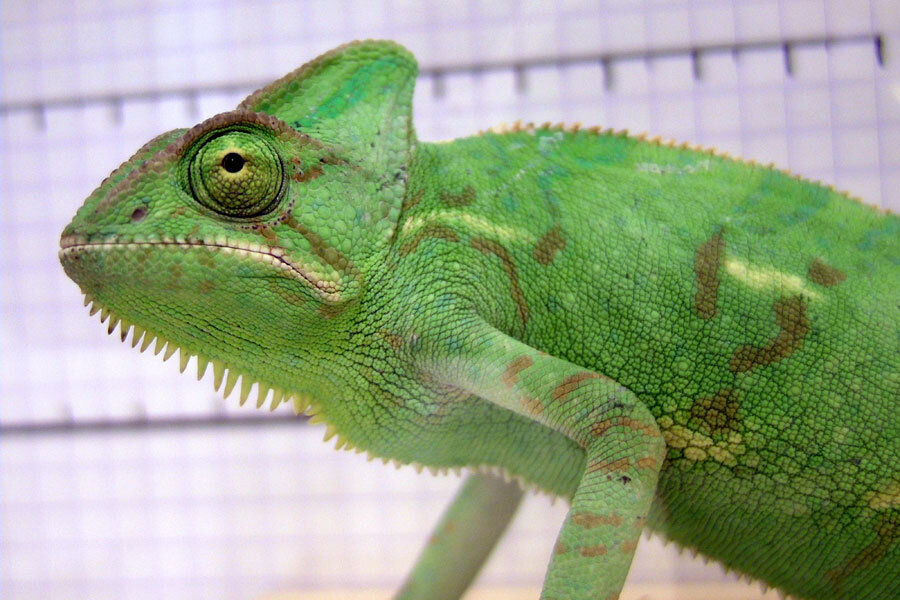How sticky spit helps chameleons catch big meals
Loading...
Chameleons have powerful, speedy tongues. If one of these colorful lizards decides it wants a snack, the unsuspecting prey is in the animal's mouth within seconds. The chameleon simply fires its long, elastic tongue out of its mouth at high speed and whips it back just as fast, with the cricket or other tasty morsel stuck to the tip of the long muscle.
But how is it that the chameleon's snack stays attached to its tongue through this whiplash-inducing ride?
Biologists have suggested several hypotheses for the mechanism behind the stickiness of chameleons' tongues, from suction to velcro, says Pascal Damman, a physicist at the University of Mons in Belgium. In fact, it could be the simplest explanation: sticky spit.
A little bit of mucus likely makes the tip of the chameleon's tongue very sticky, according to a paper published Monday in the journal Nature Physics. It is about 400 times sticker than human saliva. That's about the same viscosity as honey, Dr. Damman says.
"What we show is that the simplest explanation works," Damman, who was a co-author on the new study, tells The Christian Science Monitor in a phone interview.
Damman and his colleagues measured the viscosity of the mucus from the tongues of veiled chameleons, Chamaeleo calyptratus, to see if it was sticky enough to ensnare the large meals these lizards munch on. And they found that the chameleons' spit was a strong enough glue to pick up prey that scientists have previously reported can be 30 percent of its own body mass.
In fact, Damman says, scientists now think that the size of the prey chameleons are able to capture is limited by something other than what its tongue can pick up.
"The factor that limits the size of the prey is probably the size of the mouth of the chameleon," he says.
Chameleons swallow their prey whole, Damman explains. So if they can't fit the prey in their mouth, then they can't swallow it.
There's very little of this special sticky spit on the chameleons' tongues, so the scientists couldn't measure its properties as they would another fluid. Instead, they smeared the mucus on a slope and rolled a small bead down it. This allowed them to measure the viscosity of the chameleons' mucus by comparing how fast the bead rolled down the slope with and without the mucus on it.
"We've known for a very long time that the 'stickiness' of mucus is an important part of the tongue's adhesive mechanism in chameleons and related lizards that also use their tongues to capture prey," Kurt Schwenk, an ecologist and evolutionary biologist at the University of Connecticut who was not part of this study but has studied and written about prey capture himself, tells the Monitor in an email. "However, the current paper is the first study to actually measure the mechanical properties of the lingual mucus and to provide quantitative data on its role in tongue-prey adhesion."
But Dr. Schwenk cautions against taking this paper as proof that this sticky mucus is the only force working to keep prey attached to chameleons' tongues. "The authors do not discuss the possible roles of surface tension (or capillarity) adhesion – another type of 'wet adhesion' ... – and lingual suction, which has been demonstrated experimentally to occur in chameleons. These other types of adhesion might be especially important for large chameleons feeding on large prey when the tongue and prey item often drop and dangle for awhile while the tongue is 'reeled' back into the mouth."
The adhesion described by Damman and his colleagues is only effective when the mucus is stressed and stretched by the acceleration of the recoiling tongue, Schwenk explains. "If the mucus is stressed rapidly, it is sticky like glue; if it is stressed slowly, it behaves like a liquid and does not offer resistance."
And this is no ordinary spit, Damman says. Saliva is a lot less viscous, a lot more like water, because it needs to be mixed with food as an animal chews and digests. Instead, he says, this mucus is much more like the fluid used by snails for locomotion.
Other animals that capture prey with their tongues also have highly viscous spit, Damman says. "It would be very interesting for biologists to predict the phylogeny to see how this very special character appears during the evolution of species."
"I hope that biologists will work on this," Damman says, "because we are physicists. For us, this is the most we can do in biology."
But working on this project was "quite refreshing," the physicist says.
Chameleons' projectile tongues have attracted the attention of engineers working with soft robotics. "The tongue is a very interesting mechanism," Luis Dorfmann, principal investigator in the mechanics of soft materials laboratory at Tufts University in Medford, Mass., who was not part of this study but has studied chameleon tongues in his own work, tells the Monitor in a phone interview. It is "fantastic" how the lizard activates its muscles to "produce this projectile motion," he says.
Chameleons' "incredible, projectile tongues have mystified Western scientists for hundreds of years (the first known, published study is in the 1600s!) and even modern evolutionary biologists still have difficulty understanding how such a complex and extreme adaptation could evolve," Schwenk says.
"Engineers have come to realize that nature provides a huge laboratory of materials experimentation that cannot be surpassed by human efforts. So whatever we discover about chameleons has the potential to be applied to human benefit – like a new glue, etc." he says.
"Everything we can learn about them will help us to understand how the world works, and what our place in it is. And the icing on the cake is that such creatures have had millions of years to solve difficult mechanical problems, like how to make your tongue super-sticky."








